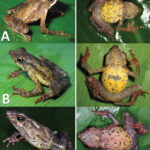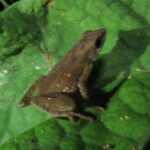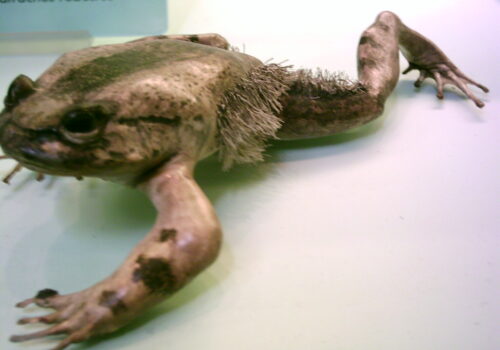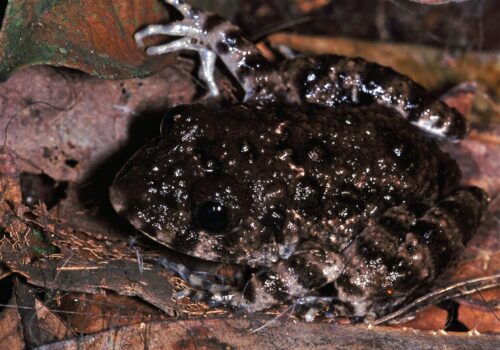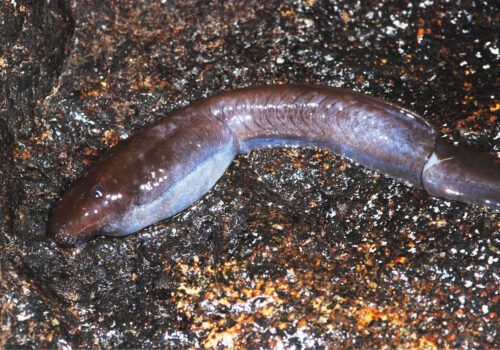- Exploring the Enigmatic Christy's Tree Frog (Leptopelis christyi): A Jewel of Central Africa's Forests
- Taxonomy and Classification: Unveiling the Lineage of Leptopelis christyi
- Natural Habitat: Life Among Central Africa's Emerald Canopies
- Physical Characteristics: Adaptations Mastered by Evolution
- Behavior and Life Cycle: Stories Told Beneath Moonlit Canopies
- Ecological Significance: Guardian of Forest Health
- Threats and Conservation Status: Protecting a Forest Jewel
- Cultural and Scientific Significance: A Frog that Informs and Inspires
- Conclusion: Conserving the Silent Guardians of the Forest Canopy
Exploring the Enigmatic Christy’s Tree Frog (Leptopelis christyi): A Jewel of Central Africa’s Forests#
Amidst the lush evergreen canopy of Central Africa’s mist-shrouded rainforests resides a small, enigmatic frog that captivates those fortunate enough to encounter it. Known scientifically as Leptopelis christyi, but more affectionately called Christy’s Tree Frog, this amphibian exemplifies the astounding diversity concealed in the dense foliage and tangled vines of the continent’s equatorial ecosystems.
Despite being relatively elusive, Christy’s Tree Frog holds immense ecological significance, intricately tied to the health of its habitat. Yet, as forests shrink at alarming rates and climate conditions shift unexpectedly, ensuring the survival of this remarkable creature becomes both a challenge and a shared responsibility.
Remarkably, the adventure into discovering Leptopelis christyi begins not just by understanding its biology and role in nature but by immersing oneself in the sights, sounds, and rhythms of its natural rainforest home. So, let’s embark on that journey together, uncovering the secrets of Christy’s Tree Frog; a creature both fascinating and profoundly worthy of our attention.
Taxonomy and Classification: Unveiling the Lineage of Leptopelis christyi#
The scientific exploration behind Leptopelis christyi places this frog firmly within the diverse family Arthroleptidae. Within this fascinating amphibian assemblage, the genus Leptopelis captures attention for its diversity and adaptive brilliance. Familiar to herpetologists primarily for its arboreal lifestyle, the genus is renowned for frogs with prominent, oversized eyes perfectly adapted for nocturnal activities in dense foliage.
First described by George Albert Boulenger in 1912, Christy’s Tree Frog honors the contributions of the esteemed explorer Dr. Cuthbert Christy, who collected pivotal specimens from the African continent during his pioneering expeditions into dense Central African forests.
Within the genus Leptopelis, Christy’s Tree Frog stands among close relatives like the Cameroon Forest Tree Frog (Leptopelis brevirostris) and the intricately patterned Garamba Tree Frog (Leptopelis calcaratus). Each species, including Christy’s, uncovers subtle yet invaluable evolutionary clues, helping scientists map biodiversity hotspots across Africa’s equatorial belt.
Natural Habitat: Life Among Central Africa’s Emerald Canopies#
Leptopelis christyi inhabits a geographical range primarily within the pristine rainforest expanses of Uganda, the Democratic Republic of the Congo, and Rwanda. Secretive by nature, these frogs thrive in humid, shaded forests characterized by dense underlayers of ferns, vines, moss-covered logs, and slow-moving streams gently trickling over the leaf-littered forest floor.
The habitat of Christy’s Tree Frog exemplifies pristine forest vitality, epitomizing the biodiversity richness these areas support. Within the forest’s layered complexity, the frogs occupy an eclectic assortment of niches—from arboreal perches among broad, waxy-leafed trees to hidden mossy clefts along shaded streams. Their environment offers rich hunting grounds where twilight transforms the area into a lively gastronomic playground of insects and small arthropods.
The moisture-laden air, shadowy understory, and abundant insect prey perfectly complement Christy’s Tree Frog’s unique evolutionary adaptations. However, their presence also signifies habitat quality—these frogs act as biological indicators of forest health, signaling subtle ecological changes that otherwise remain unnoticed by the outside observer.
Physical Characteristics: Adaptations Mastered by Evolution#
The remarkably graceful form of Christy’s Tree Frog precedes its reputation. Adult individuals commonly measure between 40 to 60 millimeters, showcasing an adaptive compactness perfectly suited for life amid narrow twigs, fern fronds, and branching vines. Their limbs, long and slender, enable them to navigate complex vegetation structures effortlessly—hopping, climbing, and leaping with fluid precision.
The colorations manifested by Leptopelis christyi exquisitely blend vibrant aesthetics with vital camouflage strategies. The dorsal surface typically features subtle shades of emerald green, olive, or brown, adorned with lighter, cryptic mottling patterns—a visual tapestry mirroring precisely the intricate shadows and patterns of their leafy environment.
Perhaps most captivating are its prominent eyes. Large, forward-facing, and displaying a mesmerizing combination of horizontal elliptical pupils nestled amidst metallic golden or copper irises, these eyes grant exceptional nocturnal visual acuity. To witness the sudden glint of these eyes reflecting the thin beams of moonlight filtering through the leafy canopy is to glimpse evolution’s sophisticated artistry firsthand.
Behavior and Life Cycle: Stories Told Beneath Moonlit Canopies#
Night Hunters of the Forest#
Christy’s Tree Frogs lead primarily nocturnal lives. Under the nocturne’s cover, the forest fills with rhythmic calls and subtle movements. Deftly positioned on branches or asymmetrical leaves, these agile predators await insect prey, relying on sharp eyesight and powerful leaps to seize opportunities as they emerge. Their diet consists mostly of small flying insects—moths, beetles, flies, and occasionally ants—that inadvertently wander onto their foliage ambush points.
A Chorus Beneath the Stars: Breeding and Courtship#
The onset of rains triggers intricate courtship rituals. Male frogs become vocal poets, issuing melodious yet haunting calls resonating deeply through the lush vegetation. Each call forms a deliberate serenade, carefully strung notes intended to attract receptive females while simultaneously warding off rival suitors.
Females, lured by these enchanting calls, reveal remarkable selectivity about mate choice. After careful assessment, the female deposits clutches of gelatinous eggs typically on shaded, submerged vegetation or hidden forest ponds. From these eggs hatch tadpoles—creatures whose morphology and aquatic lifestyle contrast starkly with the arboreal energy they will adopt upon metamorphosis.
A Transformation Amidst Forest Pools#
The developing tadpoles spend weeks or even months adapting to life underwater, feeding selectively on algae, plankton, and detritus. Eventually, metamorphosis represents nature’s most dramatic transformation experiment, whereby aquatic larvae dramatically change into miniature replicas of their arboreal guardians. Equipped now with functional limbs and lungs, a new generation of Christy’s Tree Frogs embarks on a terrestrial journey reminiscent of their ancestors—a breathtaking cycle seamlessly repeated beneath forest canopies.
Ecological Significance: Guardian of Forest Health#
Christy’s Tree Frog proves an indispensable indicator species intimately tied to the vitality and equilibrium of rainforest ecosystems. They substantially influence insect populations through predation, preventing harmful explosions of insect communities that threaten vegetation health and balance. Simultaneously, their tadpoles contribute actively to pond ecosystem cycles, fueling nutrient exchange and preventing excessive algal growth through herbivory.
Moreover, because Christy’s Tree Frogs require healthy, undisturbed forests to thrive, their presence signals intact ecosystems—affirming the delicate biodiversity balance crucial for Central African rainforests’ survival.
Threats and Conservation Status: Protecting a Forest Jewel#
Sadly, like many other species inhabiting delicate rainforest habitats, Christy’s Tree Frog faces existential threats. Habitat destruction caused by logging, agricultural expansion, mining activities, and growing infrastructures severely reduces available habitats. Climate changes also present escalating challenges, altering rainfall patterns and temperatures, consequently disrupting their finely tuned breeding cycles and survival odds.
Currently classified by the IUCN Red List as “Least Concern,” their population status requires ongoing monitoring. Nonetheless, these frogs keenly feel rapid land-use changes, meriting proactive steps to ensure habitat preservation and maintain ecological integrity. Conservation initiatives emphasize safeguarding forested areas, negotiating sustainable development paths, and engaging local communities as active stakeholders in frog and habitat protection.
Cultural and Scientific Significance: A Frog that Informs and Inspires#
Though not explicitly embedded in popular folklore, Christy’s Tree Frogs and their relatives symbolize the mysterious beauty and quiet resilience that characterize Central African rainforests. Scientifically, they offer insight into amphibian adaptations, biodiversity patterns, ecological sensitivity to climatic shifts, and broader environmental health indicators.
Ongoing research continues to unlock their potential as bio-indicators, putting frogs firmly at the center of discussions around rainforest conservation agendas and climate change mitigation.
Conclusion: Conserving the Silent Guardians of the Forest Canopy#
Christy’s Tree Frog, enigmatic in its solitary splendor, truly embodies the quiet magnificence hidden within Africa’s equatorial forests. Protecting and preserving Leptopelis christyi, their habitats, and the complex ecosystems they inhabit, proves vital—not solely for their existence but ours and the myriad creatures sharing this increasingly fragile planet.
As stewards of conservation, enthusiasts, students, and conservationists alike must band together. Exploring and supporting preservation projects, responsible ecotourism ventures, and initiatives aimed at understanding frogs like Christy’s Tree Frog becomes more critical than ever. Through collective care, we safeguard not only a captivating amphibian but a resilient, thriving natural world worthy of our wonder and respect.


